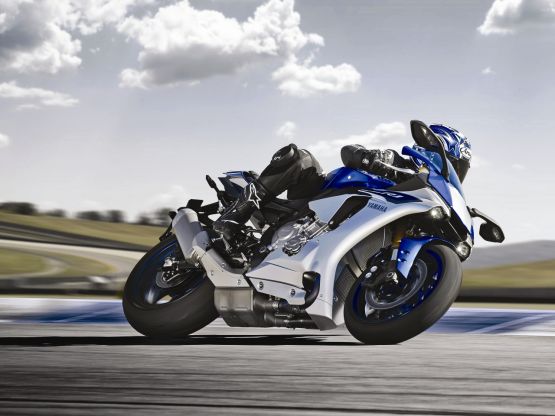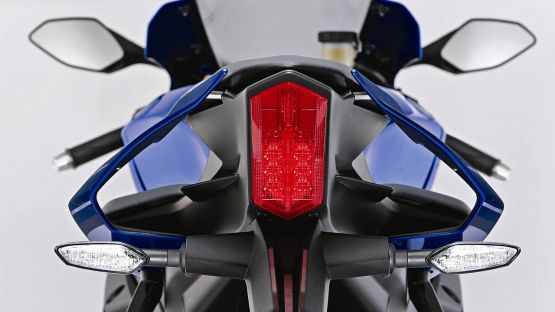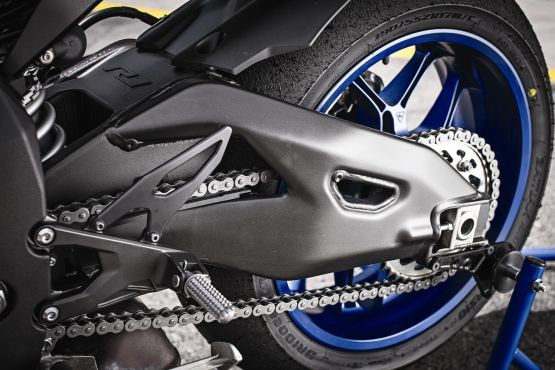 The Yamaha looks the part too; not beautiful like a Panigale, but mean and purposeful, especially when it’s sitting in its tyre-warmers in the pit-lane of the circuit that was once called Eastern Creek. The fairing has a racer-like smooth nose where a street bike’s headlight would normally be, relying for light on a pair of tiny LEDs on either side. At its flanks the fairing is cut away in places to sit flush with the engine, allowing the bike to be as narrow as possible.
The Yamaha looks the part too; not beautiful like a Panigale, but mean and purposeful, especially when it’s sitting in its tyre-warmers in the pit-lane of the circuit that was once called Eastern Creek. The fairing has a racer-like smooth nose where a street bike’s headlight would normally be, relying for light on a pair of tiny LEDs on either side. At its flanks the fairing is cut away in places to sit flush with the engine, allowing the bike to be as narrow as possible.
 The seat is quite high, at 855 millimetres, but the R1 still manages to feel light and compact. Turning the ignition key — so ordinary it seems almost out of place — illuminates the small but colourful and legible thin-film display. That sits below the fairly low, racer-like screen, and ahead of the immaculately finished top yoke, from which protrude a pair of KYB forks with neat preload, compression and rebound damping adjusters on their tops.
The seat is quite high, at 855 millimetres, but the R1 still manages to feel light and compact. Turning the ignition key — so ordinary it seems almost out of place — illuminates the small but colourful and legible thin-film display. That sits below the fairly low, racer-like screen, and ahead of the immaculately finished top yoke, from which protrude a pair of KYB forks with neat preload, compression and rebound damping adjusters on their tops.
That 16-valve motor fires up with a throaty, unmistakable crossplane-crank grumble. That engine layout remains unchanged but the motor is new, keeping its 998 cc capacity but gaining power from more over-square dimensions, higher compression ratio, new rocker-arm valve operation, narrower valve angle and the first fracture-split titanium conrods on a production bike.
The chassis is also completely new, based on an aluminium Deltabox frame that follows the YZR-M1 by having a central air intake pipe that runs through the headstock to feed an airbox that is 24 per cent larger than its predecessor. (Naturally, the injection system is also new, with a choice of four maps for throttle response.) Steering geometry is unchanged but the swing-arm and wheelbase are both shorter.
This bike’s weight saving — its claimed figure with a full tank is five kilos lighter than that of the S1000RR, whose power output is virtually identical — didn’t come by accident. The fuel-tank is made from aluminium instead of plastic; the rear subframe, engine covers and even the wheels are magnesium; the four-into-one exhaust is mostly titanium.
But it’s the electronics that bring the R1 into the battle at the front of the current superbike pack. The heart of the operation is a compact device called an IMU, or Inertial Measurement Unit. This consists of three gyros that measure pitch, roll and yaw, plus three acceleration sensors that measure forward/back, sideways and vertical movement. Between them, they can detect exactly what the bike is doing, 125 times per second.
This, in turn, has allowed Yamaha to introduce a long list of features and acronyms. Alongside the updated TCS (traction control system) there’s the new SCS (slide control system), which can detect when the rear wheel is stepping out. There’s an anti-wheelie function (called LIFt), a launch control system for race starts, and a unified brake system (UBS) that links front and rear stoppers, and adds a bit of rear brake when the front is used, depending on the lean angle.
It’s all complex stuff, and Yamaha have done a good job of making it simple to use. The levels of all the systems, including the four power modes, can be selected via a button on the left bar. On the right bar there’s another button for what’s called Yamaha Ride Control System. This allows the rider to select from four groups of all the electronic systems; so, for example, you can have one group of settings for fast road or track, a slightly softer alternative, another for town and one for rain, each one programmable with the rider’s desired levels of each electronic function.



Leave a Reply